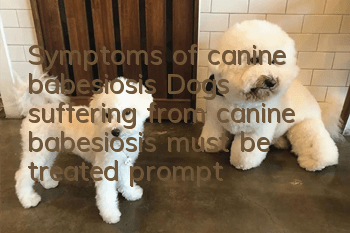Symptoms of canine babesiosis Dogs suffering from canine babesiosis must be treated promptly!

Canine babesiosis
This disease is a hematological protozoal disease transmitted by Ixodes neurotic ticks and has a global distribution.The causative agent of canine babesiosis and its life history
There are three types of causative agents of canine babesiosis:(1) Canine Babesia: the parasite is relatively small Large, generally 4 to 5 microns long, up to 7 microns long. The typical worm body is double pear seed-shaped, with the tips of the two worms connected at an acute angle. The number of worms in each red blood cell is 1 to 16.
(2) Babesia gibsoni: The worms are very small and mostly ring-shaped. The eggs are round and rarely pear-shaped. Two red blood cells can harbor up to 30 organisms.
(3) Babesia welschii: Except for being slightly larger in size, its shape is similar to Babesia canis and may be a synonym for Babesia canis. According to reports, the transmission vectors of Babesia canis are Rhipicephalus sanguineus, Dermacentor marginalis, Dermacentor reticulata, Dermacentor beautiful ticks, Haemaphysalis listeri and Hyalomma leadensis; the transmission vector of Babesia gibsoni is Rhipicephalus sanguineus. Rhipicephalus ticks, Haemaphysalis ticks and Haemaphysalis longicornis. Both species of Babesia can be transmitted through eggs or during metamorphosis.
Key points for diagnosis of canine babesiosis
(1) Epidemiological investigation to determine whether there are ticks transmitting the disease in the local area and whether it is the active season of ticks at that time. Does the sick dog have a history of tick bites or has a tick caught on its body?(2) Clinical symptoms: Canine babesiosis mainly manifests as high fever, jaundice, and difficulty breathing. Some sick dogs have enlarged spleens and are sensitive to touch. The urine contains protein and sometimes hemoglobin. Babesia gibsoni often has a chronic course, with only initial fever or intermittent fever. The sick dog was highly anemic but not jaundiced. Although he has a good appetite, he is highly emaciated, and his urine contains protein or a trace amount of hemoglobin. Sick dogs often die of exhaustion. If you can tolerate it, the anemia will gradually disappear and you will recover after 3 to 6 weeks.
(3) Laboratory examination: Collect the blood from the ear tip of the sick dog for a smear, stain it with Ginnard's solution and check it. If typical parasites are found, the diagnosis can be confirmed.
Treatment of babesiosis in dogs
Use triazamidine (Bernier, Hemeziazin) at a dosage of 3.5 mg/kg body weight, subcutaneous or intramuscular injection, 1 dose per day times, for two consecutive days. Or use imidazole, the dosage is 5 mg/kg body weight, once subcutaneously or intramuscularly, or once every 24 hours, or use 5~7 mg per kilogram body weight, once every 14 days.Prevention of canine babesiosis
First, in epidemic areas, it is necessary to do a good job in tick prevention and tick control on dogs. Insecticides, such as 25ppm deltamethrin solution, can be applied and sprayed on the dog every 7 to 10 days.Second, early detection, early diagnosis, and early treatment of sick dogs should be achieved. After a case is discovered, therapeutic doses of triazamidine and imidazole can be used for drug prevention in other healthy dogs.
Random articles
- Can dogs eat fruits and vegetables?
- What causes dogs to poop yellow and loosely?
- What should I do if my dog’s mouth is bitten?
- Will dogs die if they eat crab shells?
- Why is Teddy's eyes red?
- Teddy has diarrhea but is in good spirits
- What to do without the old dog food transition
- What exactly is parvovirus?
- Why do dogs not eat dog food?
- Top 10 Dog IQs. How many of these smart dogs do you have?



